The naval paintings of Commodore Hans Peter Holm (1847-1929), a member of an illustrious Danish naval family, are discussed, as are the service biographies of his father, who commanded the frigate JYLLAND at the Battle of Helgoland in 1864, and of his grandfather, who commanded the Danish-Norwegian naval frigate NAJADEN at the Battle of Lyngor on July 6, 1812.
af Eric Nielsen
The four paintings of Danish naval ships reproduced and discussed in this article were recently discovered to be in the possession of a Danish-American descendant of the artist, Commodore Hans Peter Holm (1847-1929) of the Danish navy.
The incredibly unique story of the Holm family of Danish naval officers, going back to at least the life of Hans Andersen of 1698-1754, makes this story of Commodore Holm’s naval paintings doubly fascinating. What is so incredibly unique about the Holm naval family to which Commodore Holm belonged is that not only did his father command the famous Danish steam frigate JYLLAND in the Battle of Helgoland in 1864, but his grandfather commanded the Danish-Norwegian frigate NAJADEN in the equally famous Battle of Lyngor in 1812.

To gain perspective of the utterly unique place of the Holm naval officers in these two particular naval battles at Helgoland and Lyngor, one needs to know that between the end of the Great Nordic War in 1719, till today, Danish warships participated in only three major naval engagements with enemy warships, i.e., at the Battles of Helgoland and Lygor, and when the Danish-Norwegian battleship PRINS CHRISTIAN FREDERIK was destroyed in action in 1808 by a British naval force that included two British battleships. Thus, naval officers from the Holm family commanded the key Danish warship in two of these final three major naval engagements in Danish naval history that involved combat with other enemy warships.
When Hans Peter Holm painted the four paintings that are reproduced and discussed here, he undoubtedly knew of the major historic roles his father and grandfather played in these two rare Danish naval battles in this latter period of Danish naval history when Denmark was actively pursuing a policy of neutrality rather than aggressive warfare.
It is a premise of this article that Holm’s knowledge of the unique family role of his father and grandfather in, for Commodore Holm, Denmark’s recent naval history, must have exercised a powerful influence on Holm’s motives in choosing and depicting the subject matter of the paintings discussed in this article.
Hans Peter Holm is referred to in this article by the final naval rank he achieved in Danish naval service, Commodore. He was promoted to this rank in 1897, after an entire life in Danish naval service, starting with his inception as a naval cadet when he was only 14 years old.
In some navies “commodore” is sometimes used as a courtesy title rather than as a formal rank, but in other navies commodore is an actual officer rank, indicating an officer below the rank of rear admiral, who commands a squadron, division, or some other detachment of naval ships. However, it is not believed, from his service biography, that Hans Peter Holm ever commanded more than one ship at a time during his Danish naval service. Apparently, in the Danish navy at the time, Commodore simply signified an intermediary rank between Captain and Rear Admiral, without significance as to special duties.
While Commodore Holm may have painted as a hobby and a form of relaxation, and as a means of creative self-expression, at least three of the four Holm paintings discussed here manifest a very serious and definite purpose in their compositional process. That apparent purpose was to symbolize and commemorate his father’s and his grandfather’s life and career in Danish naval service and the influence of their example, and to acknowledge his own resulting commitment to a career in Danish naval service.
This article’s author gained the impression that when Commodore Holm produced at least three of the four paintings discussed here, Holm was not making a general statement to others, but personal statements to himself, which contained symbolism of his family’s historic past.
The fourth Holm painting, of the Danish cruiser FYEN, is a somewhat odd composition that poses a mystery as to what this painting might actually represent, unless this painting is no more than a simple portrait of one of the most attractive Danish warships of her day, a painting without any symbolic significance. However, because of the personal symbolism apparently embodied in Holm’s other three paintings, this may be a doubtful proposition.
One primary subject of these paintings is Danish naval ships during the age of sail – all of Commodore Holm’s paintings pertain to ship-rigged Danish naval vessels. Although Commodore Holm served in the Danish navy during its historical transition from sail to steam, and although Commodore Holm himself commanded several of the Danish navy’s iron-built, steam-powered warships, and one of its first steel-hulled warships, the VALKRIEN, Commodore Holm was obviously attracted to the romance of sailing ships, with their towering masts and maze of rigging.
Although Commodore Holm does not appear to be a professionally-trained marine artist, his paintings are artistically and historically compelling for that very reason. These paintings are charming expressions of a sea officer’s service life. They are also an unusual blend of family documents and heirlooms, and also historical-artistic documents of an expressive officer who loved ships and the sea, and Danish naval service as well as his forefathers’ historic participation in that service.
Holm’s naval paintings are also valuable and unique documents because of their special “provenance,” i.e., their derivation, and therefore their association, not only with Commodore Hans Peter Holm himself as the artist and as a Danish naval officer, but also because Commodore Holm came from an illustrious Danish naval family.
Commodore Holm’s father, and his father’s father – i.e., Captain Hans Peter Holm (1772-1812), who was Commodore Hans Peter Holm’s namesake – both served as officers in the Danish navy, as did Commodore Holm’s great grandfather, Peder Holm (1725-1786), a naval Captain, and his great, great grandfather, Hans Anderson (1698-1754), who served as a naval lieutenant. This long Holm family heritage of serving as naval officers in the Danish navy during the glory days of the age of sail probably influenced Hans Peter Holm’s choice of Danish naval sailing ships as the subject matter of his paintings.
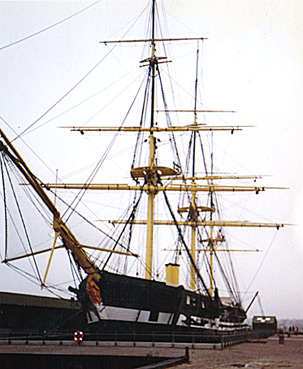
Commodore Holm’s father, the Danish naval Captain Peter Christian Holm, achieved historical notoriety when he commanded the famous Danish naval frigate JYLLAND at the Battle of Helgoland on May 9, 1864, against an Austrian-Prussian naval force which was seeking to break the Danish blockade of Germany’s seaports. This battle was the last action ever fought between ship-rigged naval ships operating in squadron formation.
The Battle of Helgoland is a celebrated one in Danish naval history, because this Danish victory was not only a tremendous morale booster, at the time it was fought, to the morale of the Danish people whose little country was facing the specter of obvious defeat in the “German” war of 1864, it is also a historical bright spot during that disastrous war for Denmark, when the home team won a rare and isolated victory for Denmark.
During the Battle of Helgoland, the major combatants on either side were wooden-hulled frigates equipped with relatively rudimentary steam engines which drove an underwater screw propeller – hence the generic term “screw frigates.” However, these screw-frigates were also square-rigged ships equipped with a full outfit of sails, and aside for the amidship funnel for the frigate’s steam engine, had every outward appearance of being a traditional sailing ship.
In fact, during the Battle of Helgoland, none of the steam powered ships on either side had their sails set, having furled all sails to avoid the risk of fire from action damage, a common precaution in naval combat during the age of sail, when vessel’s lower courses were furled – the condition of “fighting sail” – to avoid damage from flat trajectory cannon fire. Indeed, at the Battle of Helgoland, the Austrian flagship’s rigging did in fact catch fire from the Danish warships’ cannonading – principally, the fire from the JYLLAND, which was equipped with the greatest number of rifled cannon of the warships in the Danish squadron.
Captain Peter Christian Holm’s command, the JYLLAND, was the most heavily engaged of the three Danish warships comprising the Danish squadron at the Battle of Helgoland, and she also received the most combat damage. However, although Peter Christian Holm commanded the JYLLAND, the painted portrait of the Danish squadron commander, Edouard Suenson, is the Danish officer’s image most frequently reproduced regarding the Battle of Helgoland, and he was stationed aboard the frigate NIELS JUEL rather than the JYLLAND as many suppose.
The frigate JYLLAND, a beautiful and gracefully designed frigate to plans drafted by the Danish naval architect Otto Frederik Suenson (1846-1864), is now preserved as a Danish naval memorial and museum ship in the quaint coastal town of Ebeltoft, Denmark, located on the Jutland peninsula after which the JYLLAND is named.
Compared to the Battle of Helgoland, the Battle of Lyngor in 1811, in which Commodore Holm’s grandfather commanded the Danish frigate NAJADEN, is virtually unknown to English readers, although the Battle of Lyngor is one of the most written-about naval battles by Danish and Norwegian naval historians.
Returning now to Hans Peter Holm, the value of his naval paintings is also enhanced because of the striking dearth of paintings of Danish warships during the age of sail. Ironically, by comparison to this incomprehensible and almost complete absence of paintings of Danish warships, Denmark’s Royal Archives has preserved perhaps the second largest collection, of any nation in the world, of official naval plans of warships (i.e., primarily Danish warships) during the age of sail.
So many preserved official design plans, yet so few paintings, of Danish naval ships!
Like his father, Commodore Hans Peter Holm saw significant service as a shipboard commander of some of Denmark’s major warships. However, unlike his father, who had his “hour upon the stage” of Danish naval history when he commanded the frigate JYLLAND in the celebrated Battle of Helgoland, Commodore Holm never saw combat, particularly while exercising command of a warship, because Denmark was at peace during almost all of his service life.
To return once again to the concept of the “provenance” of Hans Peter Holm’s paintings of Danish naval ships, some apparently set in exotic colonial surroundings, we see that our appreciation of these paintings is significantly enhanced by their association with the Holm naval family and their interesting service history. Thus, the value of this integrated ensemble of paintings, personal and family photos, and the family history, is far greater than the value of the sum of its individual parts.
The discovery of these family paintings also offers an opportunity to glimpse a view of the life of an extended Danish naval family that represents a microcosm of the Danish naval history, as well as of Danish colonial history, of their age: the routine Danish naval service life from young cadet to the grave; the exotic colonial past in the Danish West Indies, Iceland, and the Faero Islands; the Danish navy’s transition from sail to steam, from wood to iron hulled warships, the professional achievement and satisfaction of independent shipboard command of significant Danish warships, and the celebrated naval Battle of Helgoland in 1864.
In the sweeping panorama of Danish naval and colonial history outlined above, the Holm family was there!
Biographical sketches of the Danish naval service histories of both Hans Peter Holm and his father, Peter Christian Holm, and his grandfather and namesake, Hans Peter Holm (1772-1812), and two earlier ancestors, all of who were Danish naval officers, which are important to the provenance of the Holm naval paintings, are provided below.
Service Profile: Hans Peter Holm (1847-1929)
Hans Peter Holm was born in Copenhagen in 1847, and at the young age of 14 entered into the Danish navy as a cadet, thus being two years older than his father when his father began his naval career as a Danish naval cadet at the age of 12. After six years as a cadet, H. P. Holm was promoted to Lieutenant in 1867, and two years thereafter, to the rank of 1st Lieutenant.
Hans Peter Holm’s first significant shipboard duty assignment was in 1879-1880 aboard the wooden-hull, screw-corvette DAGMAR while she conducted a round-trip voyage to the Danish West Indies, the place where H. P. Holm’s father was born.
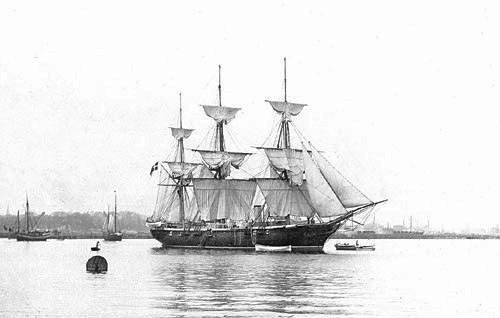
Hans Peter Holm was promoted to the rank of Captain in 1883 and received his first shipboard command in 1884, of the armored schooner ABSALON, which was apparently serving as a troop transport. ABSALON was built of iron in England in 1862, was powered with English-built, 500 horsepower steam engines, and was armed at this time with 1-60 pdr. and 2-18 pdr. rifled cannon, mounted in unique (for a Danish naval warship) pivot mounts (to provide sufficient traverse to allow for a wide arc of fire on either side of the ship), located on a central axis, with the 18 pdrs. positioned at the bow and stern. This vessel was of sleek appearance, with a large funnel amidships.
H. P. Holm’s next duty post was aboard the iron-built, 5,332 ton armored battery ship HELGOLAND (by comparison, ABSALON displaced 533 tons). HELGOLAND was an unusual design of low freeboard and something of a coastal monitor. Holm’s service aboard the HELGOLAND was followed by his command of the brig ORNEN, a wooden-hull sail training ship, in 1894, and then his command of the cruiser GEJSER in 1896, a relatively new vessel, having been built domestically in Denmark in 1892, by the commercial firm of Burmeister & Wain.
In 1897, Hans Peter Holm achieved the naval rank of Commodore, his final rank in Danish naval service.
In 1901-1902, Hans Peter Holm captained the steel-hulled cruiser VALKYRIEN (displacement: 2,972 tons; armament 2-8.2 inch and 6-5.9 inch guns, with some lighter caliber weapons) when she was acting as the “station ship” (“Stationsskib”) in the Danish West Indies.

It was during the 1901-1902 tour of duty in the Danish West Indies that Holm and the “station ship” VALKYRIEN rendered humanitarian assistance to the victims of a catastrophic volcano explosion on the French colonial island of Martinique, an explosion which caused horrific loss of life, and which constituted one of the greatest if not the greatest natural catastrophe that has ever occurred in the Carribean during recorded history.
Photographic evidence of Hans Peter Holm in uniform show him to have been a highly-decorated Danish naval officer with, among other important-looking decorations, at least two classes of the Danish Order of the Dannebrog. Unfortunately, the full list of Hans Peter Holm’s decorations, or the purposes for which they were awarded, are not known to this author.
Aside from his shipboard commands, Hans Peter Holm held important administrative appointments ashore. He retired from the navy in 1907, and died in 1929.

Service Profile: Peter Christian Holm (1807-1864), Commander of the Frigate JYLLAND
Peter Christian Holm was born in Christianssted, St. Croix, in the Danish West Indies in 1807, the son of Danish naval Captain Hans Peter Holm. At only 12 years of age, Peter Christian Holm became a cadet in the Danish navy.
The fact that his father died in 1812, when Peter Christian was only 5 years old, may have resulted in family economic hardships that influenced Peter Christian’s entry into the navy when he was only 12. However, in 1826, Peter Christian Holm became a 2nd Lieutenant, and then for five years, from 1828-1833, he was in French service, presumably for training purposes, upon the completion of which he was promoted to the rank of 1st Lieutenant, in 1834.
From April 13, 1842 to October 21, 1843, Peter Christian Holm served on the appropriately-named naval brig ST. CROIX on a round trip voyage to the Danish West Indies. In 1848, he obtained his first command, again on the brig ST. CROIX, which from April 6 to October 7. 1848, served as the watch ship in the Sound.
In 1849, again in command of the brig ST. CROIX, Holm conducted blockade duties in the Baltic Sea from March 2 to August 25, as part of Danish naval operations being conducted during the Slesvig-Holstein Revolt of 1848-1850. In 1849, during the same conflict, Holm’s brig ST. CROIX became involved in an encounter with the Prussian armed steamship DER ADLER in the Bay of Danzig.
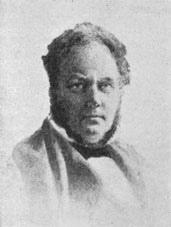
(1807-1864)
In 1850 Peter Christian Holm assumed command of the corvette DIANA and conducted a voyage to Iceland, then a dependency of Denmark, which was to be the somewhat elderly DIANA’s last voyage. In 1851, Holm was in command of the armed schooner DELPHINEN which was engaged in duties as a watch ship in the Great Belt. DELPHINEN was only lightly-armed, but provided Holm with operational experience in the handling of a schooner-rig. From March 26 to December 11, 1852, P. C. Holm served as the commander of the sail corvette GALATHEA, which was operating as a watch ship in the Sound. From August 7, 1853, Peter Christian Holm commanded the corvette VALKYRIEN which was operating as a training ship for naval cadets.
In 1854, Peter Christian Holm assumed command of the HEKLA, one of the Danish navy’s side-wheel paddle steamers, a type that did not serve long in a combat role in either the Danish or other navies. From 1856-1858, Holm saw a variation in his service duties by leaving his previous series of shipboard commands to become Port Captain of the Danish capital at Copenhagen, which seems to have been a prestige post, and a prelude to more important commands afloat.
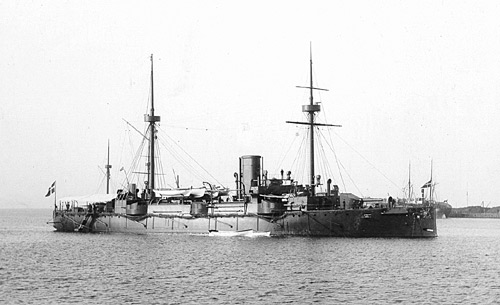
In 1860, in a major departure from the type of warships involved in his previous shipboard commands, Peter Christian Holm began a series of command appointments to the larger and more important warships in the Danish navy, commanding first the powerful frigate THETIS (48-18 pdr. cannon) from June 7th to October 5th in 1860; then the “liner” DANNEBROG, one of Denmark’s last ships-of-the-line powered exclusively by sail; and then P.C. Holm’s historically most important command, the celebrated screw-frigate JYLLAND, in which he took a leading role in the famous Battle of Helgoland.
Holm died soon after the Battle of Helgoland, and was buried in the church yard of Holmen’s Church in Copenhagen, the burial place of many of Denmark’s most significant naval officers and heros, an honor indicative of the stature of Peter Christian Holm in the Danish navy.
Hans Peter Holm (1772-1812), Captain of the Frigate NAJADEN at the Battle of Lyngor, July 6, 1812
Commodore Holm’s grandfather was also named Hans Peter Holm, and was thus Commodore Holm’s namesake. At one point in his life, Hans Peter Holm held the interesting colonial post of chief pilot and harbor master on the island of St. Croix, in the Danish West Indies, where his son (i.e., Commodore Holm’s father) was born in 1807, the year in which the British sacked Copenhagen and seized the entire Danish fleet, thus provoking the 1807-1814 Gunboat War between the Kingdom of Denmark-Norway and Britain.
After Hans Peter Holm somehow found the means to evade the British blockade and return to Denmark from the Danish West Indies following the 1807 birth of his son in the DWI, the Danish Admiralty appointed Hans Peter Holm to the command of the Danish naval brig LOLLAND, which was deployed to a station in Norway. Here off Arendal on the coast of Norway, on September 2, 1811, Hans Peter Holm brought the British naval brig MANLY to action and after a hot engagement, was then joined by two other Danish brigs which arrived to LOLLAND’s support, whereupon the MANLY surrendered. MANLY was thereafter taken into Danish naval service under the same name. Ironically, this scene of H. P. Holm’s one great naval triumph as a warship commander took place not far from where the Danish-Norwegian frigate NAJADEN would soon meet her tragic end.

Having established himself as an effective combat commander in his successful action with the brig MANLY in 1811, H. P. Holm was then selected to command of the first large Danish warship to have been built in Denmark following Britain’s 1807 sack of Copenhagen and Britain’s seizure of the entire Danish fleet, i.e., the frigate NAJADEN. This preferred command appointment, and Holm’s selection over other qualified Danish naval officers, reflected the Danish Admiralty’s high opinion of H. P. Holm’s command abilities.
The newly-built NAJADEN, which had been constructed at the Danish navy’s shipyard at Holmen in Copenhagen, departed the Danish capital on February 28, 1812, bound for Norway to join Danish-Norwegian naval units stationed in Norway. H. P. Holm undoubtedly took the NAJADEN to Norway in conformity to operational orders which Holm had been issued by the Danish admiralty. Thus, responsibility for the ensuing disaster at the Battle of Lyngor most probably must be assigned to the Danish admiralty’s faulty deployment rather than to any command decision by Holm. Unlike the Danish brigs and gunboats stationed there, the NAJADEN was simply too large and valuable a Danish warship to have been risked in the confined and unprotected Norwegian skerries.

(photo: Orlogsmuseets collection)
The NAJADEN’s ill-conceived deployment, to be stationed in the confined coastal waters and skerries of Norway, was an extremely unfortunate decision on the part of the Danish admiralty. As a result of this faulty deployment by the Danish admiralty, the ill-fated NAJADEN was destined to have an extremely short career in the Danish navy, being cornered and destroyed by the British battleship DICTATOR in the brief but brutal Battle of Lyngor on July 6, 1812, just eight months after NAJADEN was launched on October 26, 1811.
Out of NAJADEN’s establishment complement of 336 men, two thirds became casualties in the Battle of Lyngor: 127 were killed and 88 were wounded. Hans Peter Holm survived this debacle, only to be accidently drowned three months later when his dingy capsized in the Norwegian skerries. Hans Peter Holm was only 40 years old on the date of his untimely death, and his now fatherless son (and future Danish naval officer and the future commander of the frigate JYLLAND at the Battle of Helgoland in 1864) was only five years old.
Peder Holm (1725-1786)
The father of Hans Peter Holm (1772-1812) was Peder Holm (1725-1786), who achieved the rank of Captain in the Danish-Norwegian navy. As his life occurred entirely within what the Danes refer to as the “long period of peace” from 1725 to 1807, a relatively uneventful time for the Danish navy, one suspects that Peder Holm had little opportunity to achieve unique distinction during his naval service.
Hans Andersen (1698-1754)
Peder Holm’s father was Hans Andersen (1698-1754), a Danish naval lieutenant and a native of the town of Allinge on the island of Bornholm. It is just possible that Hans Andersen may have seen naval service at some point during the Great Northern War of 1709-1719, the war in which the great Danish-Norwegian admiral Tordenskiold achieved his great victories.
Commodore Hans Peter Holm’s Naval Paintings
The approximate sizes of the Holm naval paintings, in the order in which they are discussed below, are as follows:
1. The Cruiser (“Krydserfregatten”) FYEN – 15″ x 10″
2. The Adreas Schifter-Designed Frigate (or Corvette) – 10″ x 18″
3. Colonial Idyll: A Square Rigged Ship in the Danish West Indies? – 17″ x 10¼”
4. Frigate NAJADEN in the Battle of Lyngor, July 6, 1812 – 12½” x 9¼”
All of the foregoing paintings appear to be watercolors, and all are framed – with the exception of no. 3 regarding the Danish West Indies.
Researching the service life of Commodore Hans Peter Holm and his father ultimately produced some startling conclusions and inferences, which could considerably enhance the provenance of Hans Peter Holm’s naval paintings.
Inferences drawn regarding the final two Holm paintings discussed below offer a powerful clue as to Hans Peter Holm’s motives as an artist: these two paintings may have been composed as very personal commemorations of, in the case of painting “no. 3,” the birthplace of H. P. Holm’s father, and H. P. Holm’s commitment to follow in his father’s footsteps by pursuing a career in the Danish navy; and, in the case of painting “no. 4” that Commodore Holm painted this composition of the historic battle in which the NAJADEN was destroyed in order to commemorate his grandfather as his own namesake, and his grandfather’s historic achievements as a Danish naval officer – i.e., Hans Peter Holm’s own pedigree, and the ancestral pointer to Hans Peter Holm’s own personally-assumed personal destiny of a similar career in Danish naval service.
If the foregoing suppositions about Hans Peter Holm’s artistic motives are valid, they would offer a powerful basis, clue, or theme, for the further investigation of his motives in painting the first two of his paintings discussed below, particularly the first painting, in order to decipher the possible personal meaning these paintings may have had for Hans Peter Holm. Were they also commemorative paintings, of something very personal and symbolic to Hans Peter Holm? In this regard, we have some good preliminary indications as to why Holm may have painted painting “no. 2” below, of a Schifter-type Danish frigate or corvette, but there might be a stronger explanation, more personally symbolic, and perhaps related to a very specific Danish warship, more specific than the generalities offered in the explanation below that attempted to reach that very result.
The first Holm painting discussed below poses the greatest enigma. Did Holm ever serve aboard the cruiser FYEN? If not, why did Holm paint her? Did he paint the FYEN simply because the FYEN was one of the more attractive Danish naval ships of her day? And is there an explanation for the strange composition, with the unnatural-looking – and somewhat distracting – island forming a prominent artistic part of Holm’s painting?
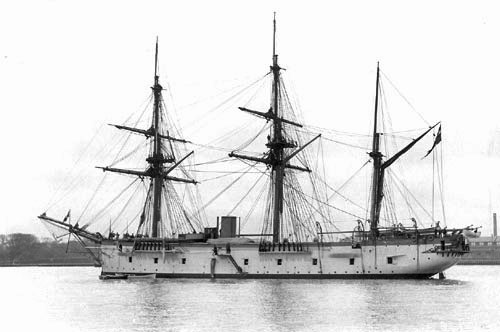
What is intriguing about Holm’s artistic interest in the FYEN, other than the artistic appeal of the FYEN’s handsome appearance, is that FYEN had virtually no service history of actual employment on operations, and Holm does not appear to have served on the FYEN. The FYEN spent nearly half of her service life, while she was still in the condition of a serviceable cruiser, laid up in inactive reserve.
The FYEN made a voyage to the Mediterranean in 1885, captained by H. G. F. Gaarde (1825-1885), who was promoted to Rear Admiral during FYEN’s cruise but died soon thereafter while aboard the FYEN, and was buried on Malta. Is an explanation for Holm’s painting that H. G. F. Gaarde was a close service friend of Holm’s father, or a service mentor to Hans Peter Holm? Is the island depicted in Holm’s painting a miniature or symbolic Malta, or just a normal harbor defense facility located on an available outcrop? Or is this line of inquiry a tangent, and is there some other, entirely unrelated, explanation? One asks these types of interpretive questions because of the apparent personal symbolism embodied in all of Holm’s other three naval paintings, as discussed below.
One suspects that Commodore Holm must have painted other pictures that these four which have survived in the possession of Holm’s Danish-American descendent. But the fact that these particular four were the ones which remained within his immediate family were the paintings which possessed the greatest significance for Holm. Because of this, and of the incredibly unique position which the Holm family of Danish naval officers played in recent Danish history, we would like to know more about them.
(1). The Cruiser (“Krydserfregatten”) FYEN
The square-rigged vessel portrayed in this painting is most certainly the Danish cruiser FYEN, whose dates as a serviceable cruiser were 1882-1907 (half these years in inactive reserve), after which FYEN was reduced to a barracks ship. FYEN’s iron hull survived in the Danish navy until 1962 – after 80 years in Danish naval service – when FYEN was broken up in Odense.

Although Hans Peter Holm never commanded the FYEN, given the gaps in Holm’s known duty assignments its just possible that Holm may have served on FYEN in some other capacity. However, entirely aside from the question of the nature or existence of Holm’s possible personal service relationship with the FYEN, when the FYEN’s hull was painted white – as it is in Hans Peter Holm’s painting – the FYEN was one of the more attractive Danish naval ships of her day.
The identity or location of the strange and almost unnatural-looking isle or rock formation to the right of the FYEN in this painting is unknown. Hence, it is also not known if this unnatural looking geographic formation actually exists in fact or is a product of Holm’s artistic imagination.
As the FYEN is the ship portrayed in Holm’s painting, perhaps the existence and location of the unnatural looking geographical outcropping in Holm’s painting may be deduced from an investigation of FYEN’s known voyages abroad, and what locations FYEN may have visited.
From October, 1885 to March, 1886, FYEN voyaged to the Mediterranean, visiting the island of Malta to bury her commander, H. G. F. Gaarde, so the Malta island group is a possible location for the strange island in Holm’s painting. We do not know to what duty station Holm was assigned during FYEN’s first voyage to the Mediterranean, and whether Holm may have been aboard either the FYEN or in an accompanying ship at this time.
FYEN’s other foreign cruises included one from October 31, 1895 to March 26, 1896, when FYEN made a voyage to the Danish West Indies, and from October 17, 1898 to February 28, 1899, made a second voyage to the Mediterranean. Therefore, the FYEN’s foreign cruises suggest the possibility that the strange geographical formation that appears in the FYEN painting, possibly a volcanic formation, may have been actually seen by Holm in either the Caribbean or in the Mediteranean. However, the record of Holm’s known duty assignments makes it unlikely Holm participated in any of these foreign voyages by the FYEN, thus creating the mystery of Holm’s possible motive for painting this particular portrait of the FYEN.
Aside from the unusual land formation that appears in the FYEN painting, one wonders if there is any symbolic significance in the large buoy that appears so prominently in the foreground of the FYEN painting. This appears to be a mooring buoy, to which ships were moored off shore by means of being shackled to the buoy. If so, does this empty and unused mooring buoy, perhaps signifying the end of a particular ship’s cruise or perhaps even the end of a particular sailor’s life at sea, have a double meaning in this instance?
(2). A Danish Naval Frigate Designed by Andreas Schifter (1779-1852), Chief Constructor of the Danish Navy (1814-1846)
The identity of the frigate in this painting is unknown. However, Hans Peter Holm had reason to be motivated to paint a portrait of one of the Danish naval frigates designed and built after the end of the Napoleonic Wars by Andreas Schifter (1779-1852), the Danish navy’s Chief Constructor (actual Danish title: “Fabrikmester”) from 1814 to 1846. That motive was that not only did Has Peter Holm’s father actually command a Schifter-designed frigate, but also as a young 14-year old boy at the time his father commanded her, Hans Peter Holm very probably saw this particular frigate with his own eyes, and was old enough to remember what he saw.

The frigate Hans Peter Holm’s father, Peter Christian Holm, commanded was the THETIS (service dates:1840-1871), and the year in which his father commanded her was 1860.
This 48-gun frigate was to a different design than an earlier series of sister-ships of closely similar dimensions to the THETIS which Schifter designed before the THETIS, whose dimensions were: length -155′ 3″; extreme beam – 38′ 6″; and maximum depth – 17′ 10″.
However, although the THETIS’s beam was actually wider than the earlier series of Schifter-designed Danish frigates, the THETIS’s transom is narrower which, in view of the larger transom in the frigate depicted in Holm’s painting, makes it less likely that the THETIS is the actual Danish frigate portrayed in the Holm painting.
Although the identity of the frigate in Holm’s painting is unknown, with its high gunport freeboard and massive sides, and with the broad and powerful transom at the stern, the frigate displays the structural characteristics of a series of powerful, 46-gun Danish frigates designed and built by Andreas Schifter after the end of the Napoleonic Wars.
These Schifter-designed frigates were all sister-ships, i.e., the FREIA (1819-1853), ROTA (1822-1863), HAVFRUEN (1825-1865), and BELLONA (1830-1862). Since the painter Hans Peter Holm had been born in 1847, it’s possible he may have actually seen any or all of these frigates during his boyhood. The dimensions of these particular frigates were: length – 155′ 3″; extreme beam – 37′ 9″; maximum draft – 17′ 2″.
The latest of the Schifter-designed frigates, built in 1843 to a completely different design, did not last long enough in the Danish navy for Hans Peter Holm to have seen her at all. This was the ill-fated GEFION, which was captured by Prussian army forces during the ill-conceived and disastrous Danish naval attack on a Prussian coastal battery at Eckernfiord in 1849, during the Slesvig-Holstein Revolt of 1848-1850.
Notwithstanding the foregoing analysis, all of the Schifter-designed frigates had roughly similar dimensions, possessed similar structural features characteristic of Schifter’s designs, and were therefore broadly comparable to one another on a visual basis, so that an imaginative painted portrayal of one could easily pass for another, or even as a generic representation of all. However, a major key to identifying the individual ships is a portrayal from the stern, to allow for an examination of the stern’s construction, decoration, and the appearance of the transom – the identifying “finger print” of a Schifter frigate.
A closer examination of the detail and decoration of this frigate’s (or corvette’s) stern in the original painting, that might not be visible in a small-scale photocopy as is reproduced here, might yield the very information by which to identify this particular Danish warship. The Danish Royal Archives has the stern decoration plans of many of Denmark’s warships under sail, including the stern decoration plans, and if the decoration plans of this warship survive, there may be an easy match.
One proposition that has not been examined here is whether this ship is actually a corvette. It is not possible to determine, from the small photocopy of the Holm painting, whether all of this ship’s guns are mounted in a single battery on a single deck, or whether any guns are mounted on the upper or weather deck. If no guns are mounted on the upper or weather deck (spar deck in U.S. usage), then the ship is most likely a corvette.
(3). Colonial Idyll: A Square Rigged Naval Ship in the Danish West Indies?
The identity and nationality of the ship-rigged vessel in this painting is unknown (or, cannot be determined from the size of this photo of the original painting), as is the case with the identity and location of the fortification in the bottom left hand corner of the painting.
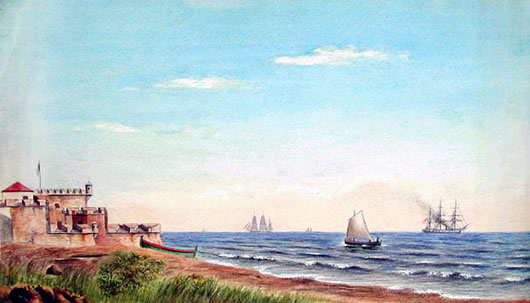
(painting by Hans Peter Holm)
The ship-rigged ship is emitting smoke amidships, indicating that she is probably a steam-powered and therefore – if a warship – is a screw-corvette or screw-frigate. In this regard, the corvette DAGMAR on which Hans Peter Holm made his first voyage to the Danish West Indies, the place of his father’s birth, was a ship-rigged screw-corvette. This round trip voyage lasted from August 7, 1879 to June 7, 1880. Therefore, it is highly likely that the warship depicted in this painting is the DAGMAR.
There were only three colonial forts in the Danish West Indies – well, actually four if one counts the one located on the small island of St. John. Two of these three are located on the island of St. Croix, and the third is located on the island of St. Thomas.
The fort of St. Thomas, Fort Christian, in the town of Charlotte Amalia, neither abuts the water, has a water battery, nor looks anything like the fort depicted in this painting and, besides, is located within a massive harbor that is partially enclosed by two jutting peninsulas and a big island in the middle of the harbor, which would presumably have been portrayed in this painting if the fort in Holm’s painting was the fort in Charlotte Amalia, St. Thomas. The secondary fort on St. Croix, Fort Frederik, is located in the town of Frederiksted, and is no more than a barracks, is not fortified, and had no raised, masonry water battery as depicted in Holm’s painting. However, Fort Christiansvaern in Christiansted, St. Croix, looks very much like the fort in Holm’s painting, though one could quibble about certain details.
Commodore Holm’s father was born in Christiansted on the island of St. Croix. When Hans Peter Holm made his first voyage to the Danish West Indies, and thus his first trip to the tropics, he was also visiting the location not only of his father’s birthplace, but of his grandfather’s presumed duty station. Thus, it appears that Holm may have painted this picture to commemorate not only his first trip to the tropics, his first visit to his father’s birthplace, but also an emotionally important voyage on the screw-corvette DAGMAR.
Holm made no voyages to either Africa or India, where other coastal Danish colonial forts were located, and thus, presuming that the colonial fort depicted in Holm’s painting is Danish, the most likely candidate for the fort in Holm’s painting is Fort Chiristiansvaern in Christiansted, St. Croix. Portraying Ft. Christiansvaern, a prominent landmark in Christainsted, where the Fort lies right on the harbor and is easily observable by mariners, would have symbolic of the birthplace of Holm’s father.
(4). Frigate NAJADEN, in the Battle of Lyngor, Near Arendal, Norway, July 6, 1812
This painting by Commodore Hans Peter Holm, of the Battle of Lyngor, in Norway, is presumably a copy he painted from the original of a well-executed and well-composed, dramatic painting by F. T. Kloss. The Kloss painting now located in Det Nationalhistorisk Museum paa Frederiksborg. However, we do not know where Hans Peter Holm might have seen this painting, or if he utilized a photograph of the painting as his model, when he executed his own copy.
Hans Peter Holm’s interest in the Battle of Lyngor was doubtless due to the fact that the Danish frigate NAJADEN, which was destroyed in this battle with great loss of life to its crew, was captained by his grandfather and namesake, Hans Peter Holm (1772-1812), and Hans Peter Holm was apparently motivated to commemorate this event by making a personal copy of the most noted painting extant depicting the battle.
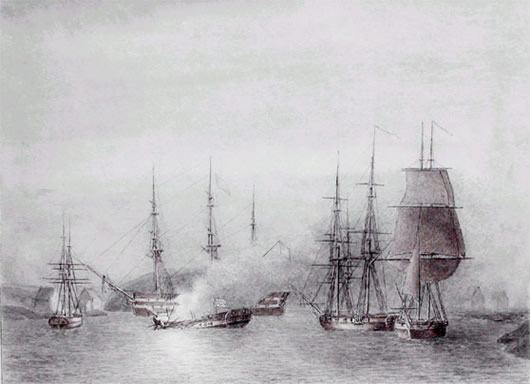
The Battle of Lyngor fjord, in Norway, near Arendal, is perhaps the most written-about battle in Danish-Norwegian naval history. Why this battle has exercised such fascination for Danish-Norwegians is incomprehensible, particularly for a U.S. citizen familiar with American naval operations during the American Revolution and the War of 1812. In these two American wars a large number of U.S. naval vessels, including a number of frigates, were destroyed in port to prevent their capture by blockading British warships, or were lost by being captured or destroyed in port due to attacks by ships of the blockading British squadrons – i.e., exactly what happened at Lyngor fjord.
The Battle of Lyngor occurred on July 6, 1812, and its principal victim was the Danish- Norwegian frigate NAJADEN, the first large ship of the Danish-Norwegian fleet to be built after the British sack of Copenhagen in 1807 and the seizure of the entire Danish-Norwegian fleet.
Both the occurrence and outcome of the Battle of Lyngor were highly predictable, due to the Danish admiralty’s faulty and ill-conceived deployment of the NAJADEN to be stationed in the confined waters of the Norwgian skerries. A group of Danish-Norwegian naval forces based in Norway, which had been harrying British convoys to the Baltic, was utilizing a sheltered but weakly-defended anchorage on the coast of Norway as a base of operations.
The British convoy route to and from the Baltic, and British warships serving as convoy escorts, passed in relatively close proximity to this Danish base of naval operations. If attacked by a superior naval force, the Danish-Norwegian warships would basically be caught, cornered in a geographic death trap in the skerries from which there was no apparent escape, except through the one entrance, which was inadequately protected by coastal batteries.
Anchored in the sheltered waters near Lyngor, which was accessed through a narrow entrance in the land surrounding the harbor, were the NAJADEN, which had recently arrived from Copenhagen, as well as the Danish-Norwegian naval brigs LOLLAND (18), SAMSO (18), and KIEL (18), together with a force of gunboats.
On July 6, 1812, a force of British warships was passing by Lyngor when they spotted the mastheads of the Danish warship lying in their anchorage, and immediately sailed into the anchorage to attack.
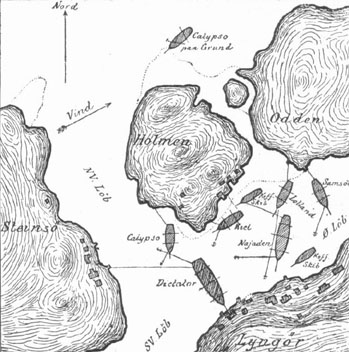
The British warships were the battleship DICTATOR (64), and the CALYPSO (18), PODARGUS (14), and FLAMER (14). PODARGUS went aground, and FLAMER was detailed to assist her, while DICTATOR and CALYPSO stood on into the anchorage, and immediately engaged the Danish warships.
NAJADEN was soon completely destroyed, as seen in the Holm copy of the Kloss painting, depicting the British battleship DICTATOR behind the sinking, burning NAJADEN. The other Danish warships struck their colors, and were taken possession of by the British. However, the following morning, Danish-Norwegian gunboats attacked the retiring British force and recovered the Danish brigs that had been taken prize.
The casualties suffered in this one-sided engagement amounted to 127 killed and 88 wounded on the NAJADEN, while the other Danish ships suffered only 6 killed and 14 wounded.
Aside from the remark above that the reason for Danish-Norwegian fascination with the Battle of Lyngor seems incomprehensible to a U.S. citizen, there may possibly be one element present in the Battle of Lyngor fjord that is the cause for this Danish-Norwegian fascination, that is, the behavior of their own sailors in combat, under very demanding conditions. The possible presence of this element has not been discussed, or indicated, in English-language descriptions of this battle. However, the Danish-Norwegian sailors most certainly endured a terrible bloodletting while being mauled by the British battleship DICTATOR.
Further reading:
R. C. Anderson, Naval Wars in the Baltic, 1522-1850, 1910.
Hans Christian Bjerg and John Erichsen, Danske Orlogsskibe 1690-1860, 1980.
Conway;s All the World’s Fighting Ships, 1860-1905, 1979.
Per Eilstrup and Nis Eric Boesgaard, Fjernt Fra Danmark: Billeder fra vore Tropekolonier, Slavehandel, og Kinafart, 1974.
Egon Eriksen and Ole L. Frantzen, Dansk Artilleri i Napoleonstiden:1760-1814, 1989.
H. G. Gaarde, Den dansk-norske Somagts Historia, 1700-1814, 1852.
H. Degenkolv, Den Danske Flaades Skibe i Sidste Aarhunderede, 1906.
Kay Larsen, Vore Orlogsskibe, 1942.
Hanne Poulen, Figureheads and Ornaments of Danish Ships and in Danish Collections, 1977.
R. Steen Steensen, Vore Krydsere, 1971.
R. Steen Steensen, Vore Panserskibe,1863-1943, 1968.
T. A. Topsoe-Jensen, Det Danske Soofficerskorps, 1801-1919.
Aside from the foregoing published sources, the author is indebted to Hans Peter Holm’s great granddaughter and Danish-American, Elisabeth Grossman, who provided valuable information and the generous use of Hans Peter Holm’s paintings and the Holm family photographs that appear in this article.
Please Contact Elisabeth Grossman, Danish-American, and Great Grand Daughter of Hans Peter Holm, Danish Naval Commodore and Naval Artist.
Elisabeth Grossman, the great granddaughter of Commodore Hans Peter Holm, and a Danish-American, is seeking information about her relatives, the Holm naval officers described in this article, and any information anyone might have regarding the paintings of Hans Peter Holm. Anyone having such information should communicate with Elisabeth Grossman at lis@truckee.net
